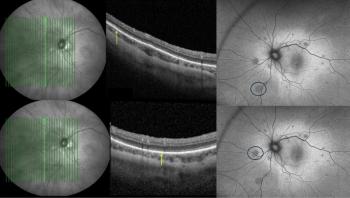
Fewer retreatments with combination AMD therapy
Providing patients with renewed hope and the chance of halting and maybe even reversing vision loss, the launch of this anti-VEGF therapy has signalled a permanent change in the way this debilitating disorder is treated worldwide.
Key Points
Study data in support of this class of drugs has been compelling; however, the dosing and follow-up regimen associated with anti-VEGF therapy and the fact that almost all subtypes of AMD are now treatable has raised several practice management problems.
Research therefore continues to find the optimum therapeutic approach to AMD therapy, which benefits from the chronic neovascularization (CNV) inhibition properties of anti-VEGF agents, and also uses the traditional therapeutic approaches to complement VEGF inhibition, whilst reducing treatment and follow-up frequency.
Speaking at the 7th International AMD Congress in Marbella, Spain, during October 2007, Dr Henry L. Hudson of Retina Centers PC in Tucson, Arizona, US discussed a study that he has been involved in, which aims to assess the effectiveness of the combination approach.
Registry of AMD therapy: Visudyne + anti-VEGF
This particular study captures data from a Registry, which was initiated in 2005 and holds information for 1195 patients with either predominantly classic lesions (46%), minimally classic lesions (31%) and no classic CNV (23%). The mean age of patients was 79.2 years and twelve-month follow-up data was available for 587 eyes (almost 50% of study participants).
In this study, the vast majority of patients were treated with the anti-VEGF bevacizumab (Avastin) administered within 14 days of Visudyne treatment. At least three-month follow-up data is available for 1?048 patients, who were segmented into one of three categories: 1) same day Visudyne + bevacizumab treatment (n=366); 2) Visudyne first (n=247); 3) bevacizumab first (n=435).
"Participation in the Registry was voluntary. Most importantly, there's an adverse events recording form, which is compulsory, unlike the original bevacizumab registry, which has been reported by others," assured Dr Hudson.
Vision benefits in all patients
"The overall vision benefit of combining anti-VEGF therapy with PDT was proven without a doubt," confirmed Dr Hudson. Based on the study results, there was a mean gain of around seven letters in the combination treatment arm, which had declined slightly by one-year follow-up.
"Of note, it takes about 4.1 months to require an additional injection of bevacizumab and 5.7 months to the next PDT session," added Dr Hudson.
When comparing treatment-naïve versus previously treated lesions, the mean vision improvement was even more marked: an eight to nine letter gain in treatment-naïve patients.
"With regards to the previously treated lesions, many were very old, and had received multiple anti-VEGF injections, previous combination therapies, you name it, and yet visual acuity gains were still seen," emphasized Dr Hudson.
Even in this group of patients, the time interval between bevacizumab injections was 3.8 to 4.4 months and five to six months to the next PDT, with nearly a third of patients requiring no retreatment at all.
A benefit was also noticeable in the same day treatment group. Although Dr Hudson concedes that this group may have contained more treatment-naïve patients than the others, thus exemplifying the benefit of same day treatment, a positive effect was seen nonetheless. "Interestingly, one sees visual benefit regardless of whether the anti-VEGF agent is given first, together or second," said Dr Hudson.
Newsletter
Get the essential updates shaping the future of pharma manufacturing and compliance—subscribe today to Pharmaceutical Technology and never miss a breakthrough.













































